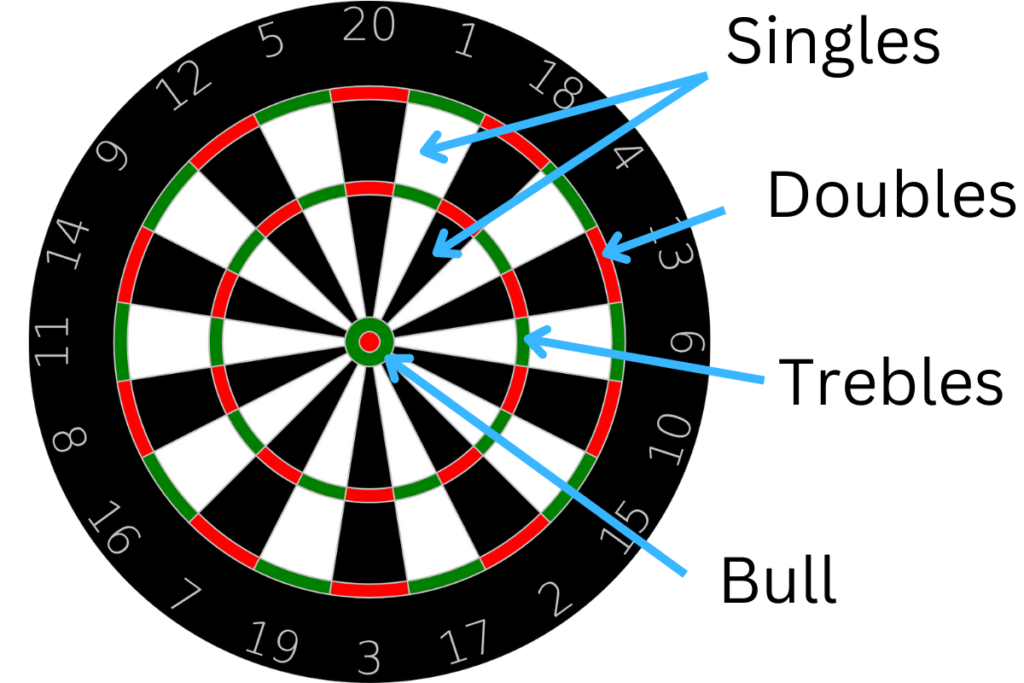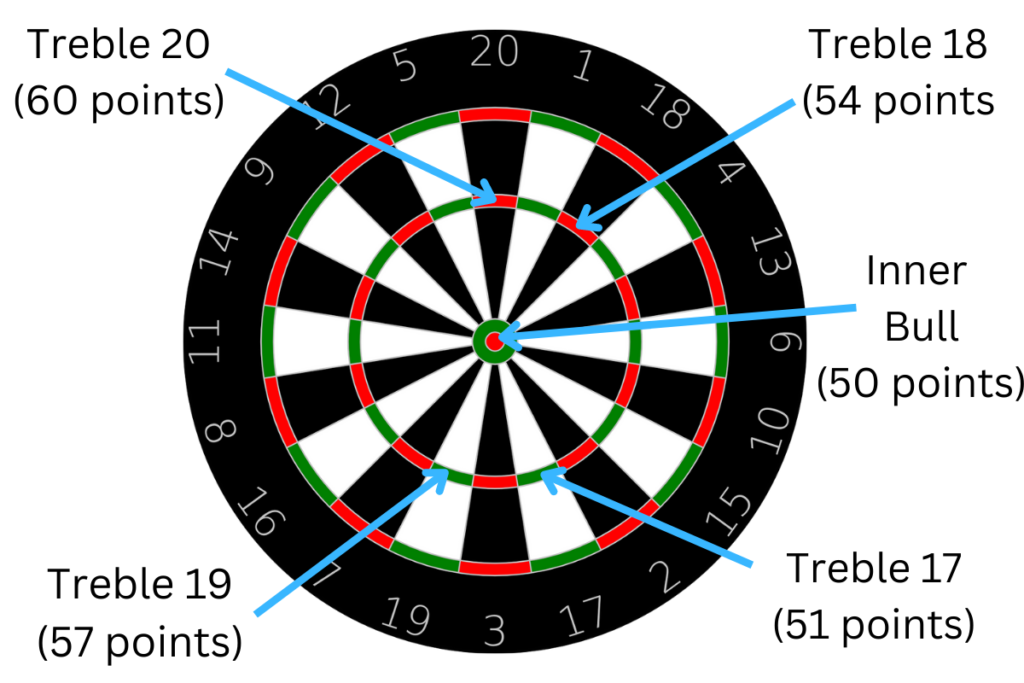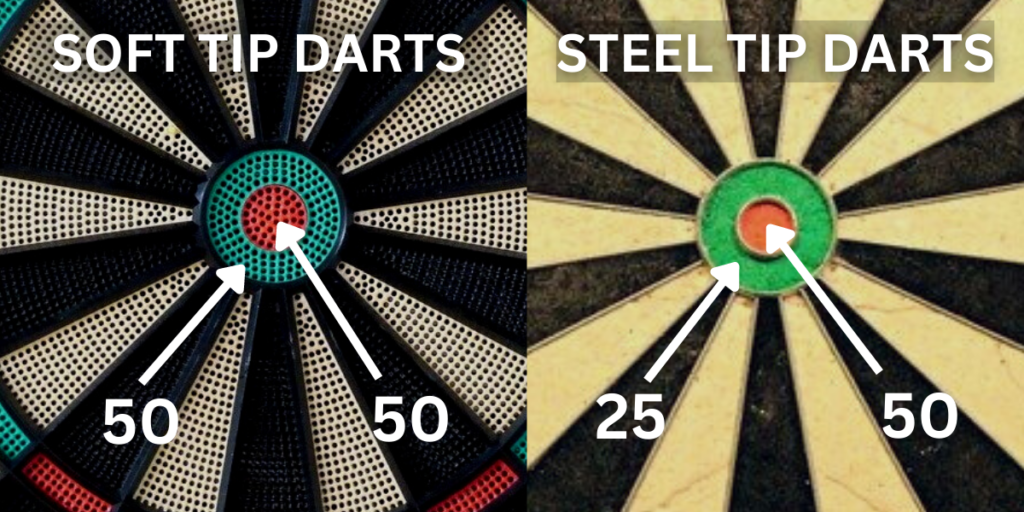If you’ve ever seen a professional darts match, you might be wondering why the players don’t aim for the bullseye. In most other target sports/ games, aiming for the centre results in the highest score, so why is darts different?
Why Do Darts Players Not Go for the Bullseye?
Darts players do not go for the bullseye because it is only the 5th highest scoring segment on the board. The inner bull scores 50 points, whereas the treble treble 17, 18, 19 and 20 all score more than 50. The bullseye also has a smaller surface area compared to the trebles so is harder to hit.
Reason #1 It Is Not the Highest Scoring Area on the Board
The main reason why darts players do not aim for the bullseye is because it is not the highest scoring segment on the board.
In a traditional game of 501 darts, the aim is for the player to reach a score of 0 starting from a score of 501. The player to do this with the fewest throws will win. Hence, it’s necessary to try and land the dart in the highest scoring segments.
There are four “types” of segments on a dartboard:
- Singles: black or white segments which are the largest areas and the scores correspond to the number dictated around the edge of the dartboard.
- Doubles: thin green or red segments on the outer ring of the dartboard. For example, if you were to hit the outer ring of the “10” segment, that dart would score 20 points.
- Trebles: thin green or red segments on the inside ring between the bullseye and the double segments. These segments are thinner than the doubles segments so score more points. Hence, a dart which lands in the treble 20 will score 60 points.
- Bull: refers to the centre of the board. The bullseye is split into two segments: the outer green segment which scores 25 points, and the inner bull which scores 50 points.

So if we do the maths and work out the scores of every segment, we’ll know that there are actually 4 segments on the board which are worth more than the inner bull which scores 50 points.
- Treble 20 = 60 points
- Treble 19 = 57 points
- Treble 18 = 54 points
- Treble 17 = 51 points
Hence, even if the treble 20 is blocked by other darts, it’s actually better to hit either a treble 19, treble 18 or treble 17 as the inner bull is only the 5th highest scoring area on the board.

Reason #2 The Surface Area of the Bullseye is Small
Another disadvantage of aiming for the inner bull is that it has a smaller surface area compared to every other segment on the board.
| Segment | Surface Area |
| Inner Bull | 1.26 cm2 |
| Treble | 3.06 cm2 |
| Double | 4.99 cm2 |
| Outer Bull | 6.65 cm2 |
| Inner Single | 14.81 cm2 |
| Outer Single | 22.88 cm2 |
The inner bull is:
- 2.4 times smaller than a treble segment
- 4 times smaller than a double segment
- 5.3 times smaller than the outer bull
- 11.8 times smaller than an inner single segment
- 18.2 times smaller than an outer single segment

This means there are actually two issues when aiming for the inner bull:
- It’s easier to miss as the target area is small
- It’s harder to group darts closely together
The key to darts is consistency. It’s easier to develop consistency when aiming at a specific area every time. The best darts players will be able to group their darts very closely together. This is difficult in the bullseye as it is a tight area and can lead to deflections.
Deflections occur when an incoming dart is knocked off its path slightly when it collides with another dart in the board. This means that why trying to group darts in the inner bull, even if you do a perfect throw, the dart could easily be deflected into the outer bull and score only 25 points.
Deflections can still occur in the double and treble segments, but it is less likely to happen as the area is wider.
Reason #3 It Can Lead to Inconsistent Scores
Finally let’s consider what happens if your darts aren’t completely accurate.
Even professional darts players don’t score treble 20 on every throw. As well as considering which segments score the highest, it’s also important to factor in what happens if your throws hit the segments on either side.
If you miss the inner bull, you may hit the outer bull which will score 25 points. However, if you miss the outer bull then you can hit any single segment. This makes the bullseye a risky place to aim for.
Instead, if you miss the treble 20, there is a high chance that you’ll instead hit a single 20. Alternatively you could hit a double 1 or 5, which would score significantly less compared to the outer bull. However, remember what we said earlier about the segment sizes?
The outer bull is 2.2x smaller than the inner single 20, and 3.4x times smaller than the outer single 20.
Hence, it’s actually more likely to score higher when aiming for the treble 20, rather than the inner bull, even if you miss.
Another good option is the treble 19, as the segments either side are 7 and 3 (higher compared to the segments either side of the treble 20 which are 1 and 5).
Why Do Soft Tip Darts Players Go for the Bullseye?
Up until now we’ve been focusing on why steel tip darts players aim for the treble 20 instead of the bullseye, but what about soft tip darts players?
Soft tip darts players aim for the bullseye because both the inner and outer bull are worth 50 points. This means there is a greater chance of scoring higher when aiming for the bullseye compared to the treble 20 when playing soft tip darts.
Throwing three bullseyes will all three darts in a single throw is known as a “hat trick”. It is much more common to see a hat trick in soft tip darts compared to steel tip darts where it makes more sense to go for the treble 20.

Here are some more articles you might find useful: